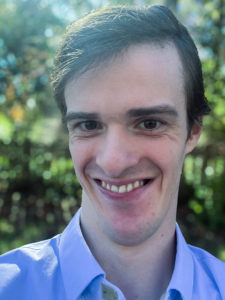blog post by Ben Gibbs
I use a variety of means of communication due to cerebral palsy. I speak verbally with my family and those familiar with my speech patterns. But for the unfamiliar listener, I have a toolkit of ways I communicate. I use gestures, facial expressions, written communication, and augmented communication through apps such as Proloquo2Go on my iPad.
When my assistive technology professor invited me to train those interacting with AAC users at the ISAAC Conference in Cancún, I honestly did not know how to react. I was [and am still] incredibly grateful for the invitation, but I just had no idea what my experience would be like since I have done nothing like this before.
I have given brief “thank you” speeches at the tail end of presentations, and presented in front of my classmates at school, of course, but this was the first opportunity I’ve had to take my knowledge gained through working towards my master’s degree and share it in a professional manner.
I said yes for exactly that opportunity. I decided to go into the assistive technology field to help people with disabilities, like and unlike my own. I saw the opportunity to help conference attendees have good interactions with service providers in Cancún, and I want to take a moment to reflect on my experience training those interacting with AAC users.
First, I feel I need to take a step back and acknowledge my favorite part of my experience in Cancún. Everyone who I met, all the people who organized the trainings, all the people who were companions to my colleagues and me, and all my colleagues and people who supported them were absolutely wonderful, to say the least. They were extremely nice and very welcoming. Leaving Cancún, I felt I had gained another family. I just felt so blessed to have been around such amazing people.
I remember when we were about to do our first presentation in front of an audience. The room we were in was probably a little larger than a standard conference room. For some reason, I had in mind that my iPad would be able to be loud enough with the room acoustics. I was badly mistaken. The iPad maybe had a three feet radius of loudness when it needed to be loud enough to reach twenty to thirty feet away. The person who oversaw the sound gave me a Bluetooth transmitter which we used to connect my iPad to the speaker system. I thought that was so cool because I associate a person who is hooked up, so to speak, to all this technology as being like a movie star or a really important figure who people want to listen to because they have something important to say.
In retrospect, I guess that was the first moment I realized how important what we were saying is. I mean, I always knew it is important, but I never got to experience sharing information about AAC firsthand.
Our days were completely booked with activity after activity. In the middle of one day, the companion person I was working with asked me if I was getting tired. I said, “yes – but what we are doing is so important because we are making a big impact on the experience that AAC users have during the conference.” Some of those who we wanted to share the information with couldn’t take time from their busy days to attend a presentation, so we went to them. One of the first places we went to was a pharmacy. Because of the information we gave, I thought about how if an AAC user went to the pharmacy to get medicine, they could access the medicine they needed, which could end up saving their life.
Furthermore, the information we gave to business workers will likely stay with them. If an AAC user decides to visit Cancún to go to the beach, maybe ten years from now, they are going to have a better experience because people who they might have to interact with know how to communicate with them. This sharing of information goes way beyond the conference.
I have been inspired by my experience and I want to share about AAC with more people. Maybe I could help bring this, or a similar, presentation to the United States. I’d like to because communication is everything. It’s how we build relationships with people, how we access goods and services, and how we interact with the world around us. Fifteen million people worldwide have difficulty communicating through traditional means. But the world society doesn’t really talk about different communication methods. It’s taken as a given, that when two people meet they don’t say, “my name is … and this is how I communicate.”
Presenting information about how to interact with people who use AAC has given me the confidence to be more open about how I communicate when I meet someone new. That is pretty big for me because I have always had difficulty when it came to meeting new people because of having a different means of communication. Will they try to get to know me? Will they ignore me because they think getting to know me isn’t worth the time? My verbal speech may be unintelligible, but even using AAC is different from traditional ways of communicating. But now I feel more confident in seeing meeting someone new as a possible opportunity to spread awareness of AAC and different means of communication.
About the Author

Ben Gibbs was diagnosed with cerebral palsy at 18 months of age. Ben’s muscles and speech are affected by the cerebral palsy. Ben communicates using speech with those who are familiar, but Ben uses AAC to communicate with the unfamiliar listener. Ben is currently studying for a master’s degree with a concentration in assistive technology, in pursuit of a career that helps people with disabilities find the right assistive technology for them.
